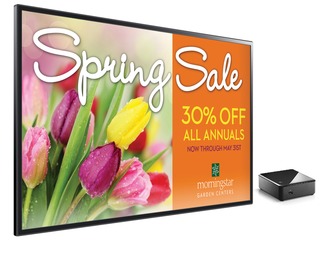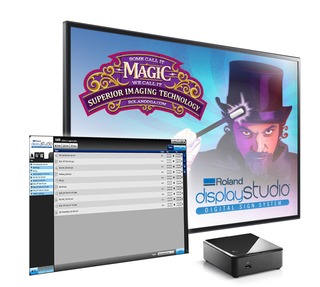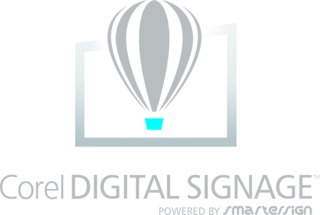Dynamic Duos: Digital Signage Heads Downmarket and Integrates with Print
As demand at all levels for digital signage grows, more and more small-business-friendly digital signage production systems are starting to appear.

A local restaurant announcing dinner specials. A bar or club promoting upcoming musical acts and events. A bookstore (remember those?) advertising upcoming author appearances and other events. You may have noticed over the past 12 months or so the slow but steady proliferation of dynamic digital signage into smaller and smaller businesses. As demand at all levels for digital signage grows, more and more small-business-friendly digital signage production systems are starting to appear.
The archetypal example of dynamic digital signage is the large, national retail or fast food chain—think of your McDonald’s or Dunkin’ Donuts menu boards—or other major deployments such as shopping malls, convention centers, universities, and airports. But these large-scale implementations are triggering more and more interest downmarket. After all, it takes a crowd to draw a crowd. But these businesses’ digital signage needs are far more modest.
“We saw an opportunity to look at those single-location, one- to two-screen-type users and we really saw that this is a market that doesn’t have a good solution today,” said Gerard Metrailler, VP of Product Management for Graphics and Productivity at Corel. “It’s very complex time-consuming for them to do it themselves.”
Corel, in partnership with SmarterSign (www.smartersign.com), a provider of cloud-based digital signage software, recently launched its own Corel Digital Signage service targeted at small businesses. It’s a subscription service—$29.95 a month per screen—that offers easy-to-use, template-driven cloud-based digital signage.
“We wanted a user, who has no idea about digital signage, to be able to have a sign up and running within 15 minutes of creating his account,” said Metrailler.
Although initially targeting end users, Corel has also found demand for a simple digital signage solution coming from print service providers.
“We’ve heard a lot from our CorelDraw signmakers that their customers are coming to them and saying, ‘You did my billboard, my sign, my car wrap. Now, can you also do my digital sign?’” said Metrailler. “They say they don’t have an easy solution to support their customers.”
Corel is hard at work tweaking its Digital Signage to allow signage producers to manage their customers’ accounts and handle maintenance and scheduling.
One of the stumbling blocks on the road to digital signage has been the emphasis on the digital aspect, rather than the content creation/management aspect. As a result, working with traditional digital signage installers (if there can be said to be anything “traditional” about digital signage) has tended to use terminology that can be unfamiliar to those in the graphic arts. “In the digital signage industry, you talk about scheduling a show, broadcasting on this channel, on this TV,” said Metrailler. “It’s very much a TV networking type of terminology, and not what a small business is aware of.”
So solutions like Corel Digital Signage aim to bring the topic home to graphic communications professionals.
An early entrant in what we might call “graphics-friendly digital signage” was Roland. Released last year at ISA’s Sign Expo 2014, Roland DisplayStudio is a “digital sign in a box,” an all-in-one system that includes software, media player, and a display. The modus operandi of DisplayStudio is to allow the user to create and schedule electronic content much as s/he would build a playlist in iTunes. Be it a video, audio, JPEG, PDF, or PowerPoint file, users drop relevant content into a playlist and publish it to a display.
Roland is first and foremost a wide-format output equipment manufacturer and as a result, the use of digital signage to complement printed display graphics has never been far from the company’s approach. Indeed, DisplayStudio was targeted from the get-go to Roland’s printer customers, allowing them to serve the thus-far underserved digital signage niche.
So far in the brief history of digital signage, the conversation has always focused on the combination of print and digital signage as separate entities. Sure, they both use the same assets, the same color schemes, and, ideally, the same visual look and feel from medium to medium, but there have been few attempts to physically combine print and digital signage—save for eye-catching exhibits at shows like the ISA Sign Expo. However, that may change. Part of the battle is showing people what is possible.
Sebastien Hanssens, VP of Marketing for Caldera—perhaps the earliest entrant in “graphics-friendly digital signage” with the company’s Variable Display combination of digital signage software and media player—gave a presentation at this year’s Sign Expo in which he called print and digital signage “the dynamic duo,” and offered some ideas and novel ways of intermingling print and digital messaging, as well as just offering some of the basics of digital signage.
“I was trying to spread the good word, that digital signage is not that difficult,” said Hanssens. “[Digital signage] just looks better when there’s print around it. People shouldn’t be saying that digital signage is apart from print. It’s just one big project. From the advertiser’s point of view, you can use digital signage for multiple messages that you can’t use in traditional signage, where there is one message.”
Take décor. A company may hire a print service provider to redo the décor in their main office or store, which communicates a certain static message about the company. But to showcase recent projects, new success stories, or communicate different messages, digital signage is the perfect complement, as it can be easily changed and updated.
However, before print and digital can be mixed, the companies producing print signage need to become comfortable with digital signage, and so far that’s been a major hurdle. But it doesn’t have to be.
“You have to take the tech out of digital signage,” said Hanssens, “otherwise signmakers think that it’s really complicated, and it’s not that complicated. You need good software, a player, and a display and that’s basically it. If you can hang a sign, you can hang a TV.”
So for Caldera, as well as Roland and Corel, the emphasis is now on content. (At this year’s Sign Expo, Roland was showing the new asset management features of DisplayStudio.)
Print service providers who have only ever worked with either camera-ready copy (remember that?), PDFs, or even InDesign files with Packaged assets, only have one type of file to work with. “When you’re in digital signage,” said Hanssens, “you have JPEGs, PowerPoints, videos. You have to know the difference between Flash and motion design, or the difference between animated graphics and video. And you need to find the right people to help you with the content.”
But then anyone who has ever worked on a catalog, magazine, event guide, or directory knows that getting a print-ready PDF file out from InDesign may involve working with content—like ads—that have been submitted in a variety of file formats: JPEG, GIF, TIFF, PDF, as well as native application files like the Adobe Creative Suite or Corel Draw, not to mention PowerPoint and Word—or even Excel. Or maybe even more abstruse file types. So managing disparate bits of content has always been part of the graphic design process.
At the end of the day, it’s just exporting a file to an output medium.
“It’s about keeping up with technology,” said Hanssens.
“There are some pretty creative things happening around digital signage,” said Corel’s Metrailler. “Combining physical and digital is definitely an area where we are firm believers. Digital is great, but it hasn’t replaced paper.”
No one thinks that digital signage will ever completely replace printed signage, and when used in combination to reinforce each other, the opportunities are there to create unique and effective signage that is greater than the sum of its parts.


